An Analysis of Digital Technology's Impact on Tesco HR Practices
VerifiedAdded on 2022/12/29
|12
|3978
|43
Report
AI Summary
This report delves into the influence of digital technology on human resource management (HRM) practices, with a specific focus on Tesco. The research explores the theoretical background, aiming to understand the concept of digital technology and its impact on HR functions such as communication, data analysis, and employee performance management. The study identifies and analyzes the challenges faced by HRM in implementing technology, including data security concerns and the need for employee training. The report justifies the importance of this research, emphasizing the disruptive nature of technology in HR and the need for in-depth knowledge in this rapidly changing field. The methodology includes a detailed description of the research approach, type, philosophy, data collection methods, research design, data analysis techniques, and ethical considerations. The report aims to provide insights into how digital technology can be effectively leveraged to enhance HR practices, improve employee performance, and overcome challenges in the retail industry. The report also offers potential solutions to these challenges and provides a comprehensive analysis of the benefits and drawbacks of technology adoption in HRM.

Managing people and careers
Paraphrase This Document
Need a fresh take? Get an instant paraphrase of this document with our AI Paraphraser
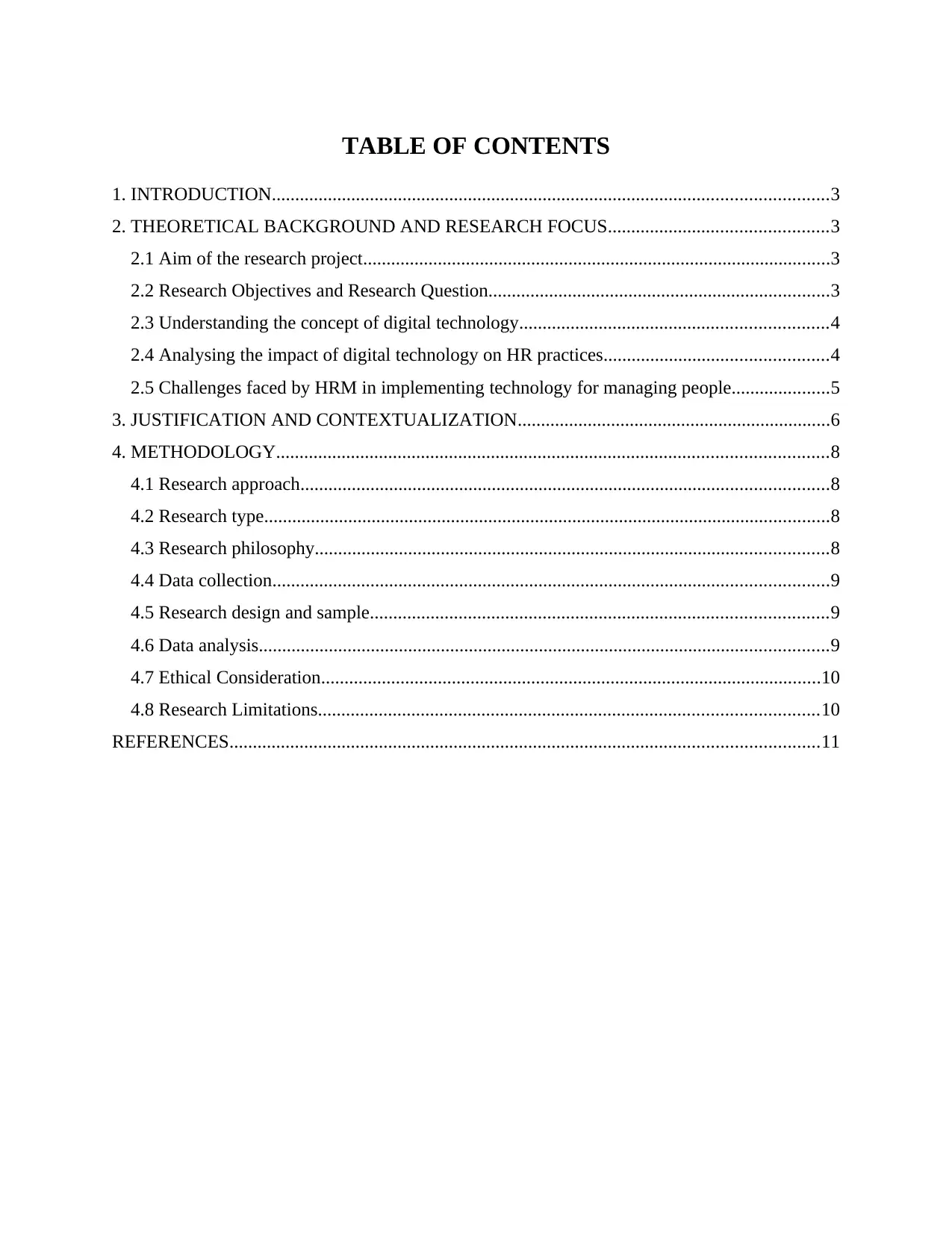
TABLE OF CONTENTS
1. INTRODUCTION.......................................................................................................................3
2. THEORETICAL BACKGROUND AND RESEARCH FOCUS...............................................3
2.1 Aim of the research project....................................................................................................3
2.2 Research Objectives and Research Question.........................................................................3
2.3 Understanding the concept of digital technology..................................................................4
2.4 Analysing the impact of digital technology on HR practices................................................4
2.5 Challenges faced by HRM in implementing technology for managing people.....................5
3. JUSTIFICATION AND CONTEXTUALIZATION...................................................................6
4. METHODOLOGY......................................................................................................................8
4.1 Research approach.................................................................................................................8
4.2 Research type.........................................................................................................................8
4.3 Research philosophy..............................................................................................................8
4.4 Data collection.......................................................................................................................9
4.5 Research design and sample..................................................................................................9
4.6 Data analysis..........................................................................................................................9
4.7 Ethical Consideration...........................................................................................................10
4.8 Research Limitations...........................................................................................................10
REFERENCES..............................................................................................................................11
1. INTRODUCTION.......................................................................................................................3
2. THEORETICAL BACKGROUND AND RESEARCH FOCUS...............................................3
2.1 Aim of the research project....................................................................................................3
2.2 Research Objectives and Research Question.........................................................................3
2.3 Understanding the concept of digital technology..................................................................4
2.4 Analysing the impact of digital technology on HR practices................................................4
2.5 Challenges faced by HRM in implementing technology for managing people.....................5
3. JUSTIFICATION AND CONTEXTUALIZATION...................................................................6
4. METHODOLOGY......................................................................................................................8
4.1 Research approach.................................................................................................................8
4.2 Research type.........................................................................................................................8
4.3 Research philosophy..............................................................................................................8
4.4 Data collection.......................................................................................................................9
4.5 Research design and sample..................................................................................................9
4.6 Data analysis..........................................................................................................................9
4.7 Ethical Consideration...........................................................................................................10
4.8 Research Limitations...........................................................................................................10
REFERENCES..............................................................................................................................11
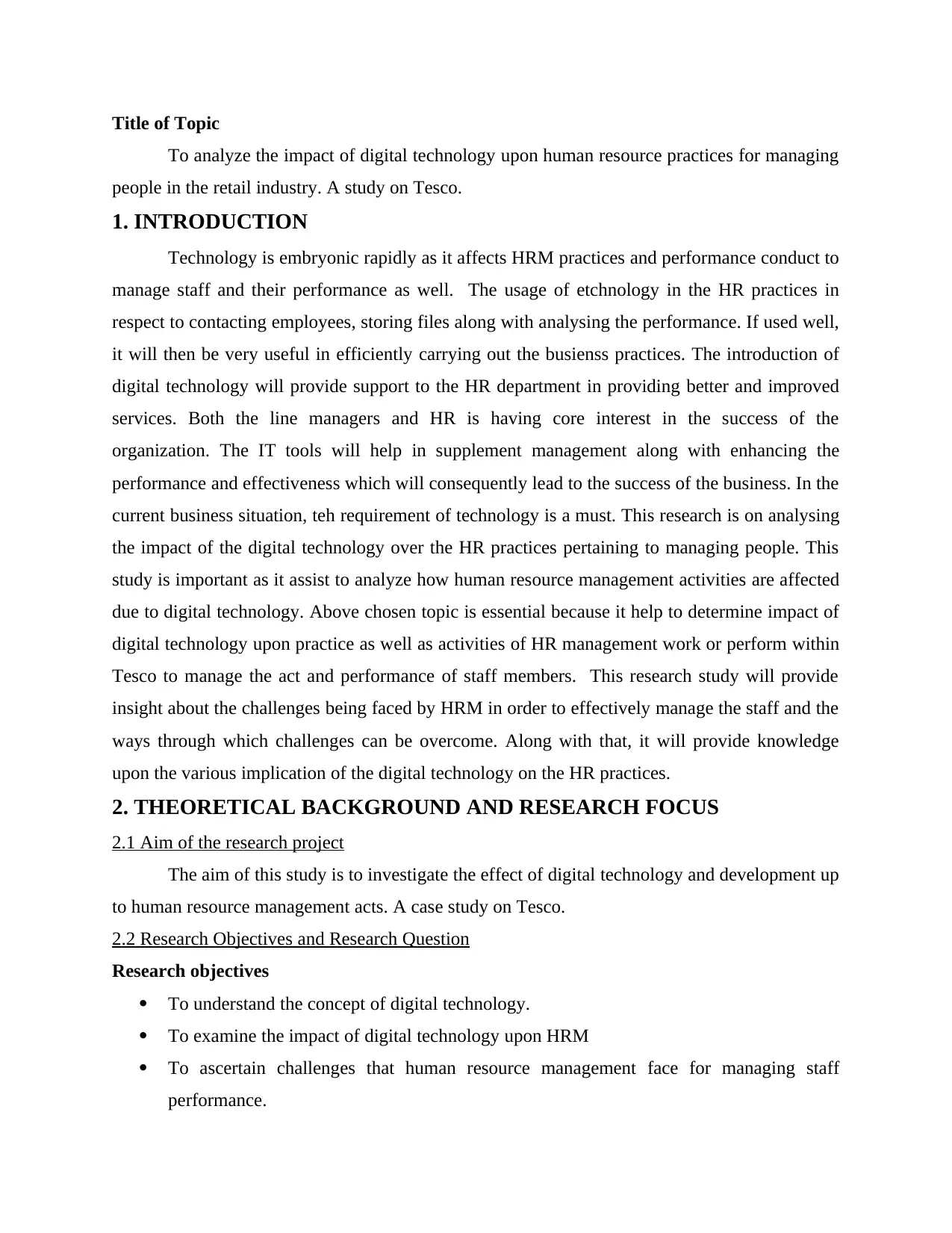
Title of Topic
To analyze the impact of digital technology upon human resource practices for managing
people in the retail industry. A study on Tesco.
1. INTRODUCTION
Technology is embryonic rapidly as it affects HRM practices and performance conduct to
manage staff and their performance as well. The usage of etchnology in the HR practices in
respect to contacting employees, storing files along with analysing the performance. If used well,
it will then be very useful in efficiently carrying out the busienss practices. The introduction of
digital technology will provide support to the HR department in providing better and improved
services. Both the line managers and HR is having core interest in the success of the
organization. The IT tools will help in supplement management along with enhancing the
performance and effectiveness which will consequently lead to the success of the business. In the
current business situation, teh requirement of technology is a must. This research is on analysing
the impact of the digital technology over the HR practices pertaining to managing people. This
study is important as it assist to analyze how human resource management activities are affected
due to digital technology. Above chosen topic is essential because it help to determine impact of
digital technology upon practice as well as activities of HR management work or perform within
Tesco to manage the act and performance of staff members. This research study will provide
insight about the challenges being faced by HRM in order to effectively manage the staff and the
ways through which challenges can be overcome. Along with that, it will provide knowledge
upon the various implication of the digital technology on the HR practices.
2. THEORETICAL BACKGROUND AND RESEARCH FOCUS
2.1 Aim of the research project
The aim of this study is to investigate the effect of digital technology and development up
to human resource management acts. A case study on Tesco.
2.2 Research Objectives and Research Question
Research objectives
To understand the concept of digital technology.
To examine the impact of digital technology upon HRM
To ascertain challenges that human resource management face for managing staff
performance.
To analyze the impact of digital technology upon human resource practices for managing
people in the retail industry. A study on Tesco.
1. INTRODUCTION
Technology is embryonic rapidly as it affects HRM practices and performance conduct to
manage staff and their performance as well. The usage of etchnology in the HR practices in
respect to contacting employees, storing files along with analysing the performance. If used well,
it will then be very useful in efficiently carrying out the busienss practices. The introduction of
digital technology will provide support to the HR department in providing better and improved
services. Both the line managers and HR is having core interest in the success of the
organization. The IT tools will help in supplement management along with enhancing the
performance and effectiveness which will consequently lead to the success of the business. In the
current business situation, teh requirement of technology is a must. This research is on analysing
the impact of the digital technology over the HR practices pertaining to managing people. This
study is important as it assist to analyze how human resource management activities are affected
due to digital technology. Above chosen topic is essential because it help to determine impact of
digital technology upon practice as well as activities of HR management work or perform within
Tesco to manage the act and performance of staff members. This research study will provide
insight about the challenges being faced by HRM in order to effectively manage the staff and the
ways through which challenges can be overcome. Along with that, it will provide knowledge
upon the various implication of the digital technology on the HR practices.
2. THEORETICAL BACKGROUND AND RESEARCH FOCUS
2.1 Aim of the research project
The aim of this study is to investigate the effect of digital technology and development up
to human resource management acts. A case study on Tesco.
2.2 Research Objectives and Research Question
Research objectives
To understand the concept of digital technology.
To examine the impact of digital technology upon HRM
To ascertain challenges that human resource management face for managing staff
performance.
⊘ This is a preview!⊘
Do you want full access?
Subscribe today to unlock all pages.

Trusted by 1+ million students worldwide
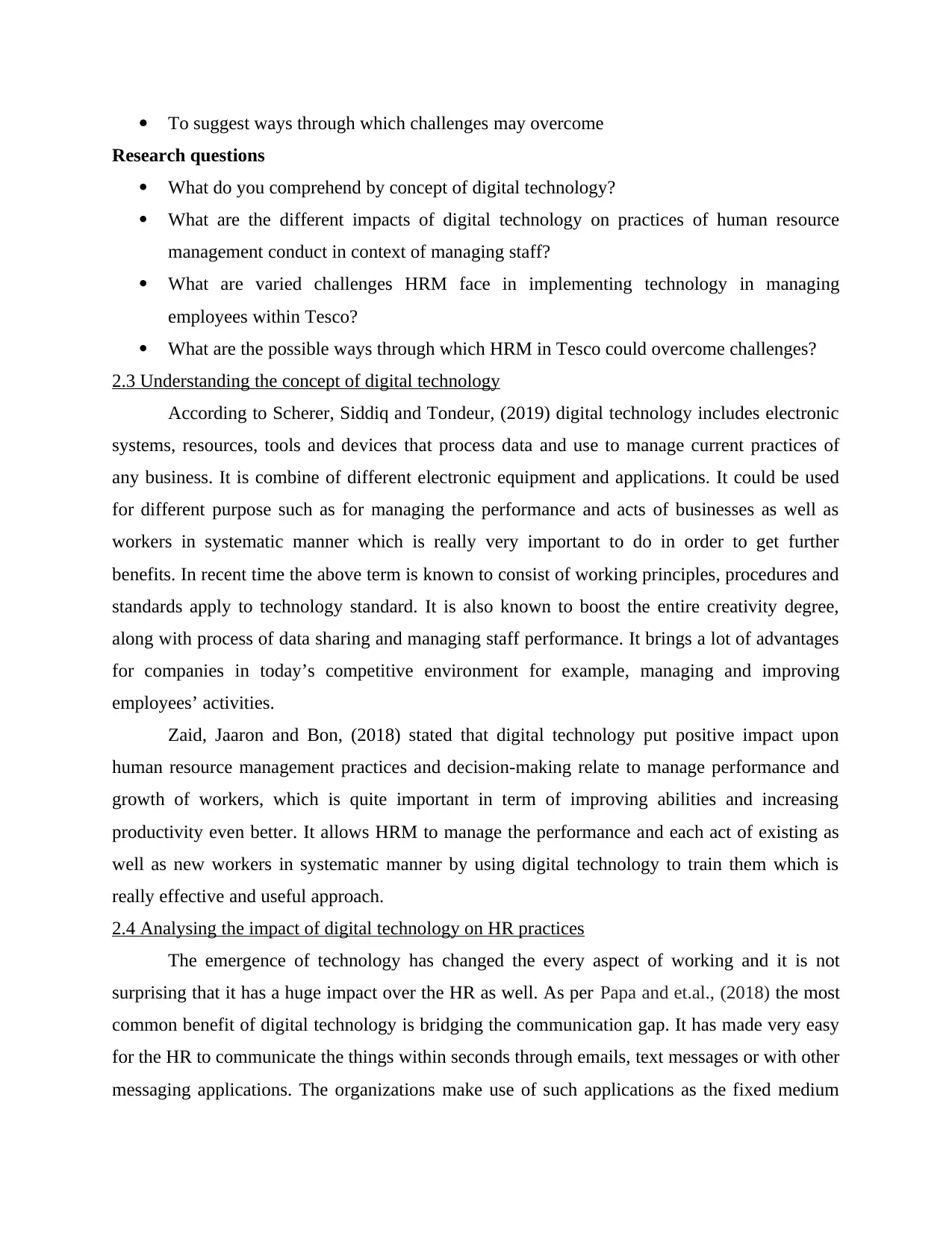
To suggest ways through which challenges may overcome
Research questions
What do you comprehend by concept of digital technology?
What are the different impacts of digital technology on practices of human resource
management conduct in context of managing staff?
What are varied challenges HRM face in implementing technology in managing
employees within Tesco?
What are the possible ways through which HRM in Tesco could overcome challenges?
2.3 Understanding the concept of digital technology
According to Scherer, Siddiq and Tondeur, (2019) digital technology includes electronic
systems, resources, tools and devices that process data and use to manage current practices of
any business. It is combine of different electronic equipment and applications. It could be used
for different purpose such as for managing the performance and acts of businesses as well as
workers in systematic manner which is really very important to do in order to get further
benefits. In recent time the above term is known to consist of working principles, procedures and
standards apply to technology standard. It is also known to boost the entire creativity degree,
along with process of data sharing and managing staff performance. It brings a lot of advantages
for companies in today’s competitive environment for example, managing and improving
employees’ activities.
Zaid, Jaaron and Bon, (2018) stated that digital technology put positive impact upon
human resource management practices and decision-making relate to manage performance and
growth of workers, which is quite important in term of improving abilities and increasing
productivity even better. It allows HRM to manage the performance and each act of existing as
well as new workers in systematic manner by using digital technology to train them which is
really effective and useful approach.
2.4 Analysing the impact of digital technology on HR practices
The emergence of technology has changed the every aspect of working and it is not
surprising that it has a huge impact over the HR as well. As per Papa and et.al., (2018) the most
common benefit of digital technology is bridging the communication gap. It has made very easy
for the HR to communicate the things within seconds through emails, text messages or with other
messaging applications. The organizations make use of such applications as the fixed medium
Research questions
What do you comprehend by concept of digital technology?
What are the different impacts of digital technology on practices of human resource
management conduct in context of managing staff?
What are varied challenges HRM face in implementing technology in managing
employees within Tesco?
What are the possible ways through which HRM in Tesco could overcome challenges?
2.3 Understanding the concept of digital technology
According to Scherer, Siddiq and Tondeur, (2019) digital technology includes electronic
systems, resources, tools and devices that process data and use to manage current practices of
any business. It is combine of different electronic equipment and applications. It could be used
for different purpose such as for managing the performance and acts of businesses as well as
workers in systematic manner which is really very important to do in order to get further
benefits. In recent time the above term is known to consist of working principles, procedures and
standards apply to technology standard. It is also known to boost the entire creativity degree,
along with process of data sharing and managing staff performance. It brings a lot of advantages
for companies in today’s competitive environment for example, managing and improving
employees’ activities.
Zaid, Jaaron and Bon, (2018) stated that digital technology put positive impact upon
human resource management practices and decision-making relate to manage performance and
growth of workers, which is quite important in term of improving abilities and increasing
productivity even better. It allows HRM to manage the performance and each act of existing as
well as new workers in systematic manner by using digital technology to train them which is
really effective and useful approach.
2.4 Analysing the impact of digital technology on HR practices
The emergence of technology has changed the every aspect of working and it is not
surprising that it has a huge impact over the HR as well. As per Papa and et.al., (2018) the most
common benefit of digital technology is bridging the communication gap. It has made very easy
for the HR to communicate the things within seconds through emails, text messages or with other
messaging applications. The organizations make use of such applications as the fixed medium
Paraphrase This Document
Need a fresh take? Get an instant paraphrase of this document with our AI Paraphraser
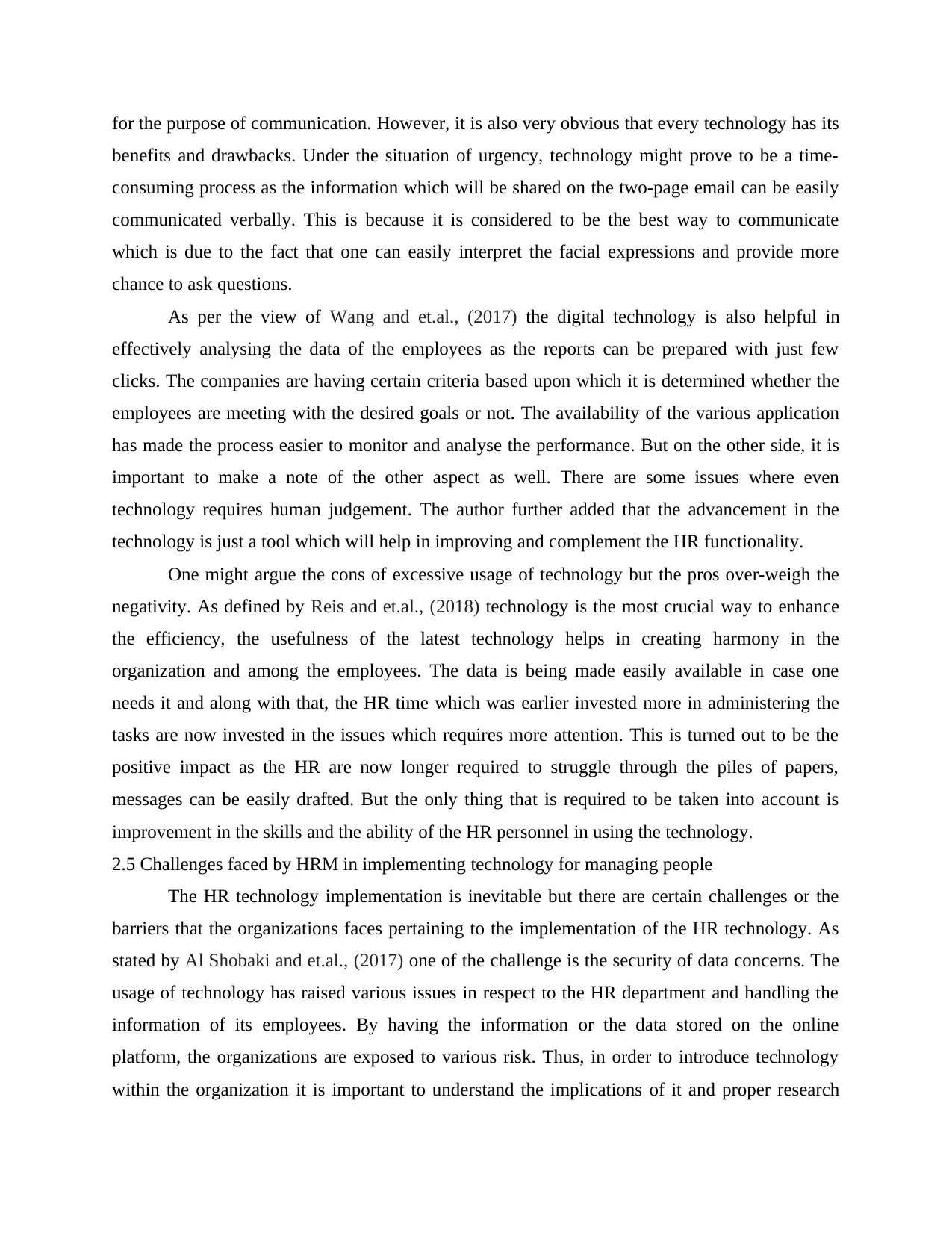
for the purpose of communication. However, it is also very obvious that every technology has its
benefits and drawbacks. Under the situation of urgency, technology might prove to be a time-
consuming process as the information which will be shared on the two-page email can be easily
communicated verbally. This is because it is considered to be the best way to communicate
which is due to the fact that one can easily interpret the facial expressions and provide more
chance to ask questions.
As per the view of Wang and et.al., (2017) the digital technology is also helpful in
effectively analysing the data of the employees as the reports can be prepared with just few
clicks. The companies are having certain criteria based upon which it is determined whether the
employees are meeting with the desired goals or not. The availability of the various application
has made the process easier to monitor and analyse the performance. But on the other side, it is
important to make a note of the other aspect as well. There are some issues where even
technology requires human judgement. The author further added that the advancement in the
technology is just a tool which will help in improving and complement the HR functionality.
One might argue the cons of excessive usage of technology but the pros over-weigh the
negativity. As defined by Reis and et.al., (2018) technology is the most crucial way to enhance
the efficiency, the usefulness of the latest technology helps in creating harmony in the
organization and among the employees. The data is being made easily available in case one
needs it and along with that, the HR time which was earlier invested more in administering the
tasks are now invested in the issues which requires more attention. This is turned out to be the
positive impact as the HR are now longer required to struggle through the piles of papers,
messages can be easily drafted. But the only thing that is required to be taken into account is
improvement in the skills and the ability of the HR personnel in using the technology.
2.5 Challenges faced by HRM in implementing technology for managing people
The HR technology implementation is inevitable but there are certain challenges or the
barriers that the organizations faces pertaining to the implementation of the HR technology. As
stated by Al Shobaki and et.al., (2017) one of the challenge is the security of data concerns. The
usage of technology has raised various issues in respect to the HR department and handling the
information of its employees. By having the information or the data stored on the online
platform, the organizations are exposed to various risk. Thus, in order to introduce technology
within the organization it is important to understand the implications of it and proper research
benefits and drawbacks. Under the situation of urgency, technology might prove to be a time-
consuming process as the information which will be shared on the two-page email can be easily
communicated verbally. This is because it is considered to be the best way to communicate
which is due to the fact that one can easily interpret the facial expressions and provide more
chance to ask questions.
As per the view of Wang and et.al., (2017) the digital technology is also helpful in
effectively analysing the data of the employees as the reports can be prepared with just few
clicks. The companies are having certain criteria based upon which it is determined whether the
employees are meeting with the desired goals or not. The availability of the various application
has made the process easier to monitor and analyse the performance. But on the other side, it is
important to make a note of the other aspect as well. There are some issues where even
technology requires human judgement. The author further added that the advancement in the
technology is just a tool which will help in improving and complement the HR functionality.
One might argue the cons of excessive usage of technology but the pros over-weigh the
negativity. As defined by Reis and et.al., (2018) technology is the most crucial way to enhance
the efficiency, the usefulness of the latest technology helps in creating harmony in the
organization and among the employees. The data is being made easily available in case one
needs it and along with that, the HR time which was earlier invested more in administering the
tasks are now invested in the issues which requires more attention. This is turned out to be the
positive impact as the HR are now longer required to struggle through the piles of papers,
messages can be easily drafted. But the only thing that is required to be taken into account is
improvement in the skills and the ability of the HR personnel in using the technology.
2.5 Challenges faced by HRM in implementing technology for managing people
The HR technology implementation is inevitable but there are certain challenges or the
barriers that the organizations faces pertaining to the implementation of the HR technology. As
stated by Al Shobaki and et.al., (2017) one of the challenge is the security of data concerns. The
usage of technology has raised various issues in respect to the HR department and handling the
information of its employees. By having the information or the data stored on the online
platform, the organizations are exposed to various risk. Thus, in order to introduce technology
within the organization it is important to understand the implications of it and proper research
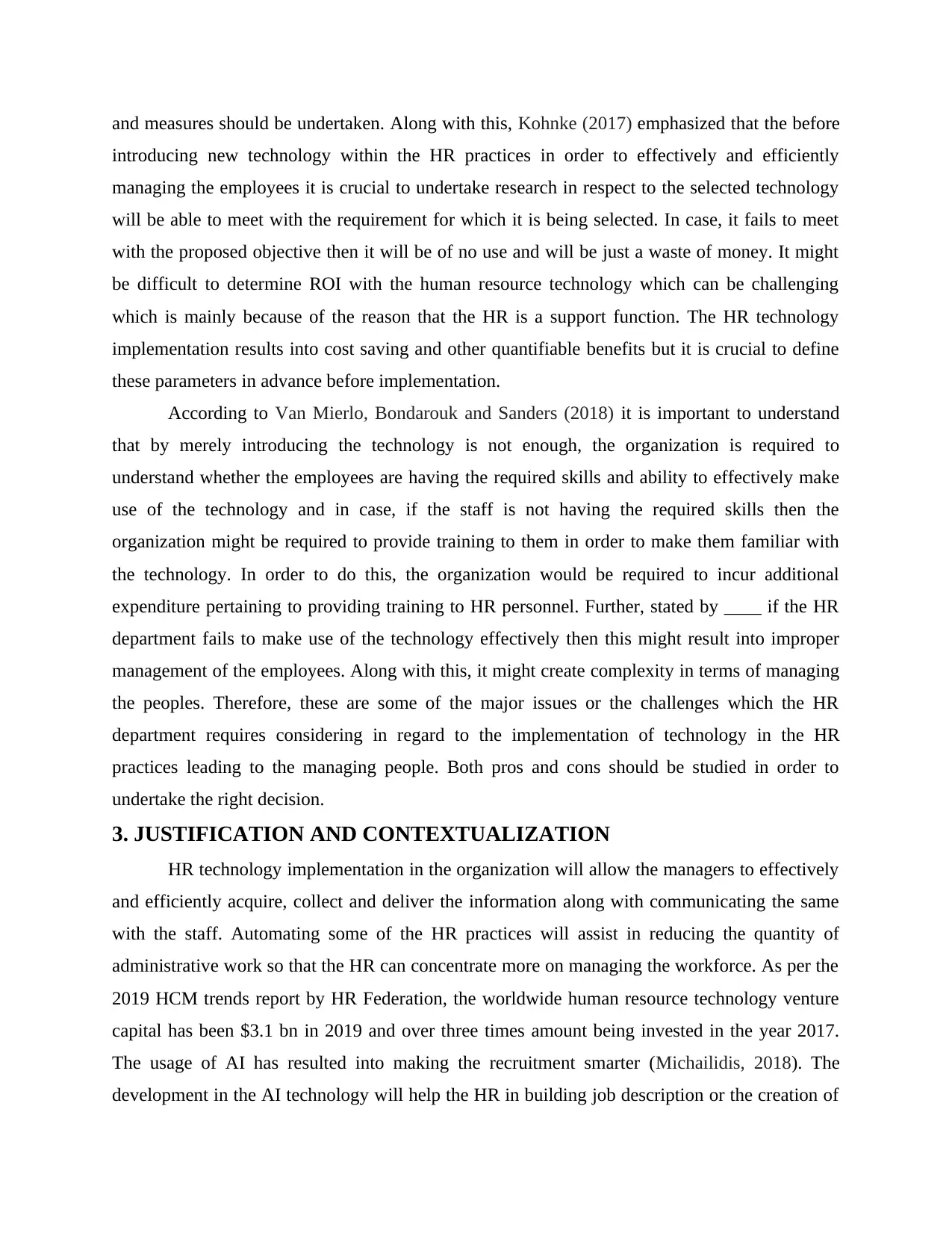
and measures should be undertaken. Along with this, Kohnke (2017) emphasized that the before
introducing new technology within the HR practices in order to effectively and efficiently
managing the employees it is crucial to undertake research in respect to the selected technology
will be able to meet with the requirement for which it is being selected. In case, it fails to meet
with the proposed objective then it will be of no use and will be just a waste of money. It might
be difficult to determine ROI with the human resource technology which can be challenging
which is mainly because of the reason that the HR is a support function. The HR technology
implementation results into cost saving and other quantifiable benefits but it is crucial to define
these parameters in advance before implementation.
According to Van Mierlo, Bondarouk and Sanders (2018) it is important to understand
that by merely introducing the technology is not enough, the organization is required to
understand whether the employees are having the required skills and ability to effectively make
use of the technology and in case, if the staff is not having the required skills then the
organization might be required to provide training to them in order to make them familiar with
the technology. In order to do this, the organization would be required to incur additional
expenditure pertaining to providing training to HR personnel. Further, stated by ____ if the HR
department fails to make use of the technology effectively then this might result into improper
management of the employees. Along with this, it might create complexity in terms of managing
the peoples. Therefore, these are some of the major issues or the challenges which the HR
department requires considering in regard to the implementation of technology in the HR
practices leading to the managing people. Both pros and cons should be studied in order to
undertake the right decision.
3. JUSTIFICATION AND CONTEXTUALIZATION
HR technology implementation in the organization will allow the managers to effectively
and efficiently acquire, collect and deliver the information along with communicating the same
with the staff. Automating some of the HR practices will assist in reducing the quantity of
administrative work so that the HR can concentrate more on managing the workforce. As per the
2019 HCM trends report by HR Federation, the worldwide human resource technology venture
capital has been $3.1 bn in 2019 and over three times amount being invested in the year 2017.
The usage of AI has resulted into making the recruitment smarter (Michailidis, 2018). The
development in the AI technology will help the HR in building job description or the creation of
introducing new technology within the HR practices in order to effectively and efficiently
managing the employees it is crucial to undertake research in respect to the selected technology
will be able to meet with the requirement for which it is being selected. In case, it fails to meet
with the proposed objective then it will be of no use and will be just a waste of money. It might
be difficult to determine ROI with the human resource technology which can be challenging
which is mainly because of the reason that the HR is a support function. The HR technology
implementation results into cost saving and other quantifiable benefits but it is crucial to define
these parameters in advance before implementation.
According to Van Mierlo, Bondarouk and Sanders (2018) it is important to understand
that by merely introducing the technology is not enough, the organization is required to
understand whether the employees are having the required skills and ability to effectively make
use of the technology and in case, if the staff is not having the required skills then the
organization might be required to provide training to them in order to make them familiar with
the technology. In order to do this, the organization would be required to incur additional
expenditure pertaining to providing training to HR personnel. Further, stated by ____ if the HR
department fails to make use of the technology effectively then this might result into improper
management of the employees. Along with this, it might create complexity in terms of managing
the peoples. Therefore, these are some of the major issues or the challenges which the HR
department requires considering in regard to the implementation of technology in the HR
practices leading to the managing people. Both pros and cons should be studied in order to
undertake the right decision.
3. JUSTIFICATION AND CONTEXTUALIZATION
HR technology implementation in the organization will allow the managers to effectively
and efficiently acquire, collect and deliver the information along with communicating the same
with the staff. Automating some of the HR practices will assist in reducing the quantity of
administrative work so that the HR can concentrate more on managing the workforce. As per the
2019 HCM trends report by HR Federation, the worldwide human resource technology venture
capital has been $3.1 bn in 2019 and over three times amount being invested in the year 2017.
The usage of AI has resulted into making the recruitment smarter (Michailidis, 2018). The
development in the AI technology will help the HR in building job description or the creation of
⊘ This is a preview!⊘
Do you want full access?
Subscribe today to unlock all pages.

Trusted by 1+ million students worldwide
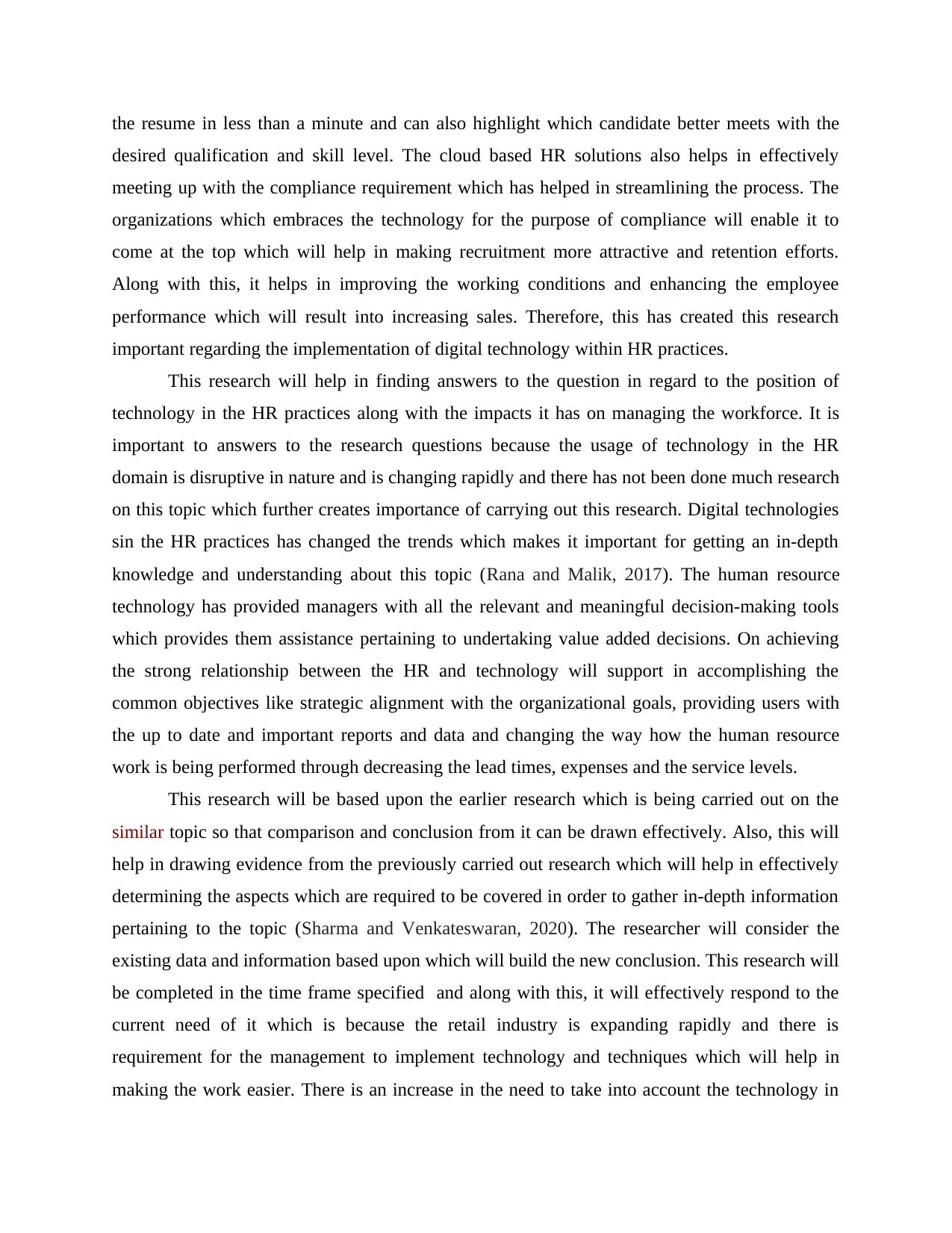
the resume in less than a minute and can also highlight which candidate better meets with the
desired qualification and skill level. The cloud based HR solutions also helps in effectively
meeting up with the compliance requirement which has helped in streamlining the process. The
organizations which embraces the technology for the purpose of compliance will enable it to
come at the top which will help in making recruitment more attractive and retention efforts.
Along with this, it helps in improving the working conditions and enhancing the employee
performance which will result into increasing sales. Therefore, this has created this research
important regarding the implementation of digital technology within HR practices.
This research will help in finding answers to the question in regard to the position of
technology in the HR practices along with the impacts it has on managing the workforce. It is
important to answers to the research questions because the usage of technology in the HR
domain is disruptive in nature and is changing rapidly and there has not been done much research
on this topic which further creates importance of carrying out this research. Digital technologies
sin the HR practices has changed the trends which makes it important for getting an in-depth
knowledge and understanding about this topic (Rana and Malik, 2017). The human resource
technology has provided managers with all the relevant and meaningful decision-making tools
which provides them assistance pertaining to undertaking value added decisions. On achieving
the strong relationship between the HR and technology will support in accomplishing the
common objectives like strategic alignment with the organizational goals, providing users with
the up to date and important reports and data and changing the way how the human resource
work is being performed through decreasing the lead times, expenses and the service levels.
This research will be based upon the earlier research which is being carried out on the
similar topic so that comparison and conclusion from it can be drawn effectively. Also, this will
help in drawing evidence from the previously carried out research which will help in effectively
determining the aspects which are required to be covered in order to gather in-depth information
pertaining to the topic (Sharma and Venkateswaran, 2020). The researcher will consider the
existing data and information based upon which will build the new conclusion. This research will
be completed in the time frame specified and along with this, it will effectively respond to the
current need of it which is because the retail industry is expanding rapidly and there is
requirement for the management to implement technology and techniques which will help in
making the work easier. There is an increase in the need to take into account the technology in
desired qualification and skill level. The cloud based HR solutions also helps in effectively
meeting up with the compliance requirement which has helped in streamlining the process. The
organizations which embraces the technology for the purpose of compliance will enable it to
come at the top which will help in making recruitment more attractive and retention efforts.
Along with this, it helps in improving the working conditions and enhancing the employee
performance which will result into increasing sales. Therefore, this has created this research
important regarding the implementation of digital technology within HR practices.
This research will help in finding answers to the question in regard to the position of
technology in the HR practices along with the impacts it has on managing the workforce. It is
important to answers to the research questions because the usage of technology in the HR
domain is disruptive in nature and is changing rapidly and there has not been done much research
on this topic which further creates importance of carrying out this research. Digital technologies
sin the HR practices has changed the trends which makes it important for getting an in-depth
knowledge and understanding about this topic (Rana and Malik, 2017). The human resource
technology has provided managers with all the relevant and meaningful decision-making tools
which provides them assistance pertaining to undertaking value added decisions. On achieving
the strong relationship between the HR and technology will support in accomplishing the
common objectives like strategic alignment with the organizational goals, providing users with
the up to date and important reports and data and changing the way how the human resource
work is being performed through decreasing the lead times, expenses and the service levels.
This research will be based upon the earlier research which is being carried out on the
similar topic so that comparison and conclusion from it can be drawn effectively. Also, this will
help in drawing evidence from the previously carried out research which will help in effectively
determining the aspects which are required to be covered in order to gather in-depth information
pertaining to the topic (Sharma and Venkateswaran, 2020). The researcher will consider the
existing data and information based upon which will build the new conclusion. This research will
be completed in the time frame specified and along with this, it will effectively respond to the
current need of it which is because the retail industry is expanding rapidly and there is
requirement for the management to implement technology and techniques which will help in
making the work easier. There is an increase in the need to take into account the technology in
Paraphrase This Document
Need a fresh take? Get an instant paraphrase of this document with our AI Paraphraser
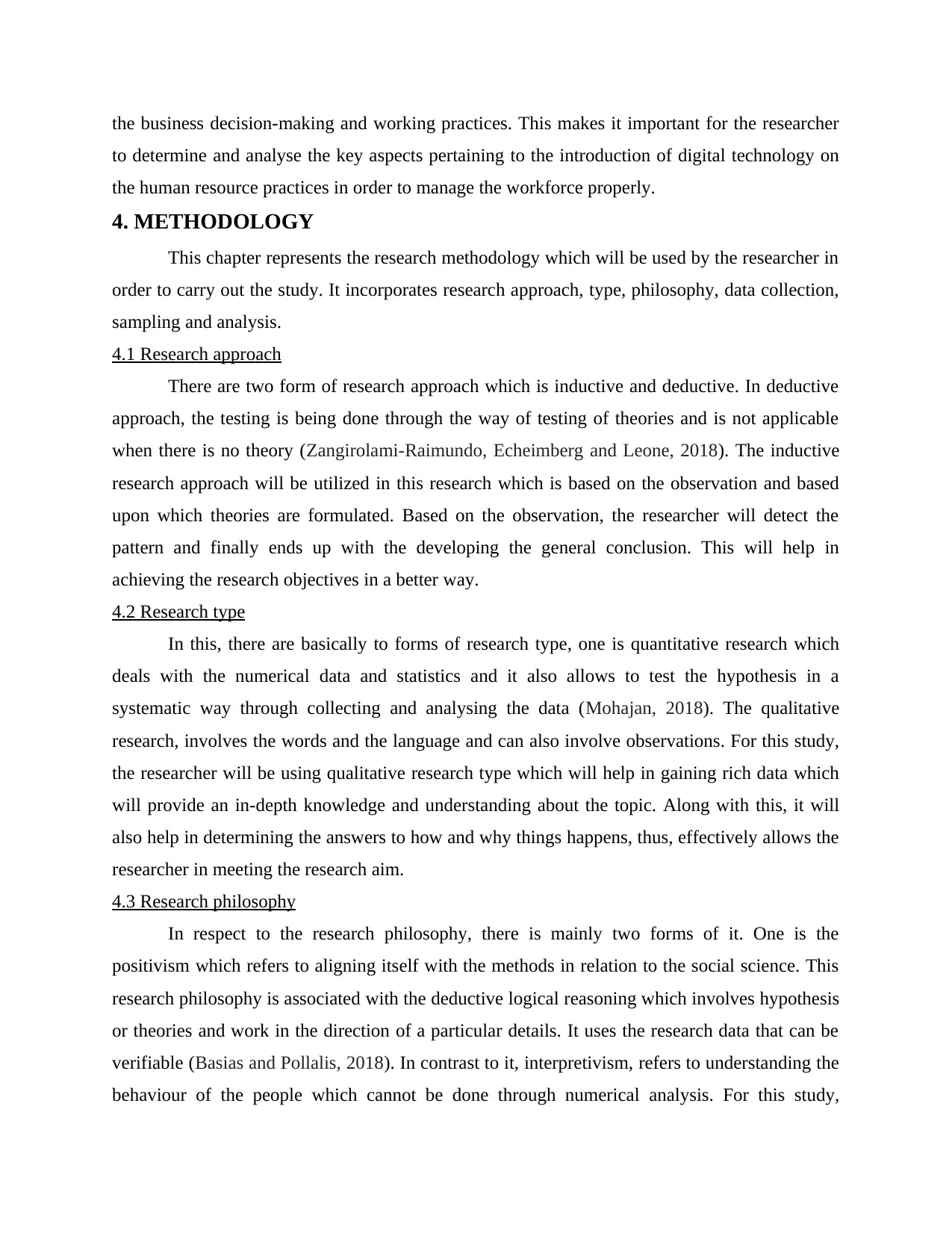
the business decision-making and working practices. This makes it important for the researcher
to determine and analyse the key aspects pertaining to the introduction of digital technology on
the human resource practices in order to manage the workforce properly.
4. METHODOLOGY
This chapter represents the research methodology which will be used by the researcher in
order to carry out the study. It incorporates research approach, type, philosophy, data collection,
sampling and analysis.
4.1 Research approach
There are two form of research approach which is inductive and deductive. In deductive
approach, the testing is being done through the way of testing of theories and is not applicable
when there is no theory (Zangirolami-Raimundo, Echeimberg and Leone, 2018). The inductive
research approach will be utilized in this research which is based on the observation and based
upon which theories are formulated. Based on the observation, the researcher will detect the
pattern and finally ends up with the developing the general conclusion. This will help in
achieving the research objectives in a better way.
4.2 Research type
In this, there are basically to forms of research type, one is quantitative research which
deals with the numerical data and statistics and it also allows to test the hypothesis in a
systematic way through collecting and analysing the data (Mohajan, 2018). The qualitative
research, involves the words and the language and can also involve observations. For this study,
the researcher will be using qualitative research type which will help in gaining rich data which
will provide an in-depth knowledge and understanding about the topic. Along with this, it will
also help in determining the answers to how and why things happens, thus, effectively allows the
researcher in meeting the research aim.
4.3 Research philosophy
In respect to the research philosophy, there is mainly two forms of it. One is the
positivism which refers to aligning itself with the methods in relation to the social science. This
research philosophy is associated with the deductive logical reasoning which involves hypothesis
or theories and work in the direction of a particular details. It uses the research data that can be
verifiable (Basias and Pollalis, 2018). In contrast to it, interpretivism, refers to understanding the
behaviour of the people which cannot be done through numerical analysis. For this study,
to determine and analyse the key aspects pertaining to the introduction of digital technology on
the human resource practices in order to manage the workforce properly.
4. METHODOLOGY
This chapter represents the research methodology which will be used by the researcher in
order to carry out the study. It incorporates research approach, type, philosophy, data collection,
sampling and analysis.
4.1 Research approach
There are two form of research approach which is inductive and deductive. In deductive
approach, the testing is being done through the way of testing of theories and is not applicable
when there is no theory (Zangirolami-Raimundo, Echeimberg and Leone, 2018). The inductive
research approach will be utilized in this research which is based on the observation and based
upon which theories are formulated. Based on the observation, the researcher will detect the
pattern and finally ends up with the developing the general conclusion. This will help in
achieving the research objectives in a better way.
4.2 Research type
In this, there are basically to forms of research type, one is quantitative research which
deals with the numerical data and statistics and it also allows to test the hypothesis in a
systematic way through collecting and analysing the data (Mohajan, 2018). The qualitative
research, involves the words and the language and can also involve observations. For this study,
the researcher will be using qualitative research type which will help in gaining rich data which
will provide an in-depth knowledge and understanding about the topic. Along with this, it will
also help in determining the answers to how and why things happens, thus, effectively allows the
researcher in meeting the research aim.
4.3 Research philosophy
In respect to the research philosophy, there is mainly two forms of it. One is the
positivism which refers to aligning itself with the methods in relation to the social science. This
research philosophy is associated with the deductive logical reasoning which involves hypothesis
or theories and work in the direction of a particular details. It uses the research data that can be
verifiable (Basias and Pollalis, 2018). In contrast to it, interpretivism, refers to understanding the
behaviour of the people which cannot be done through numerical analysis. For this study,
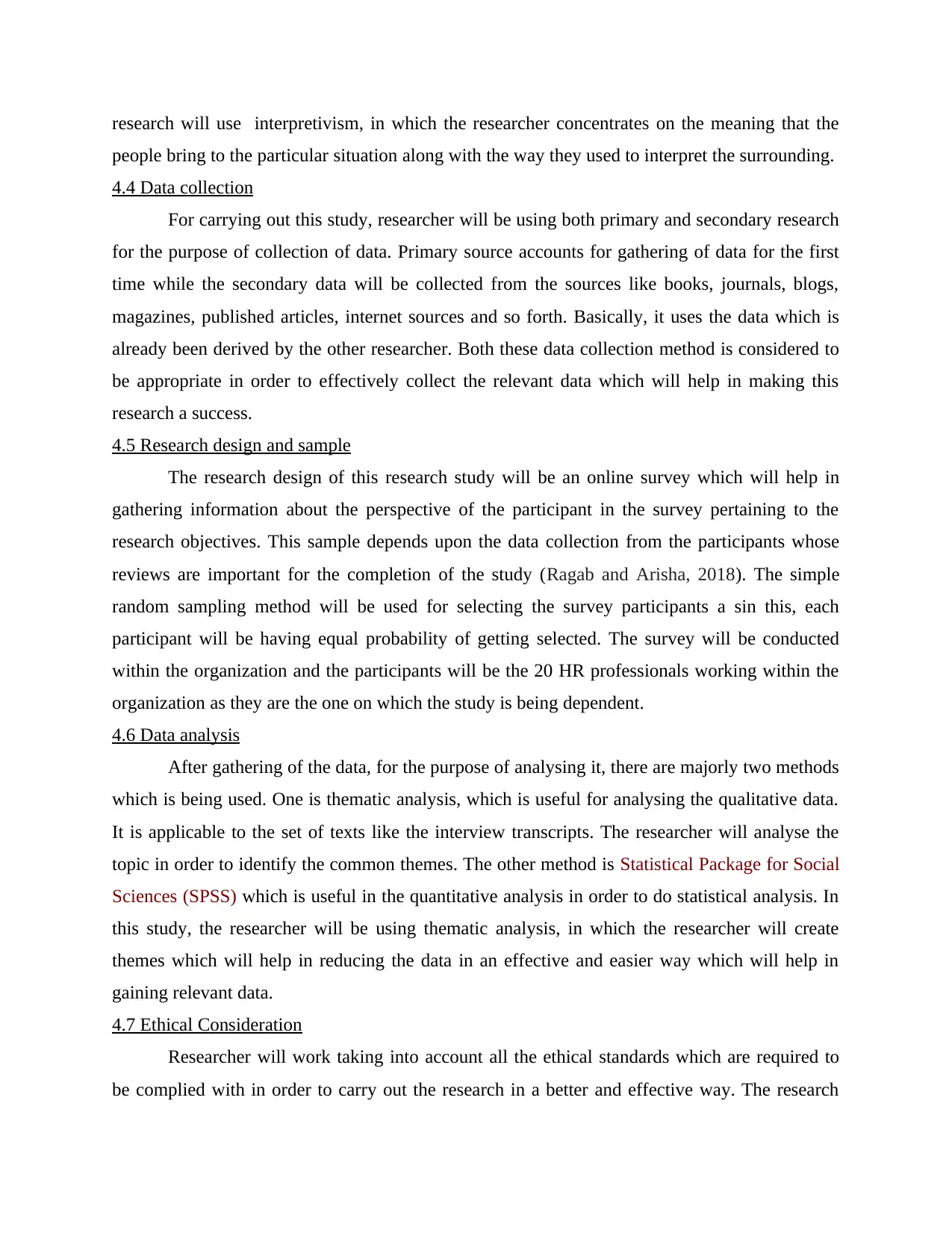
research will use interpretivism, in which the researcher concentrates on the meaning that the
people bring to the particular situation along with the way they used to interpret the surrounding.
4.4 Data collection
For carrying out this study, researcher will be using both primary and secondary research
for the purpose of collection of data. Primary source accounts for gathering of data for the first
time while the secondary data will be collected from the sources like books, journals, blogs,
magazines, published articles, internet sources and so forth. Basically, it uses the data which is
already been derived by the other researcher. Both these data collection method is considered to
be appropriate in order to effectively collect the relevant data which will help in making this
research a success.
4.5 Research design and sample
The research design of this research study will be an online survey which will help in
gathering information about the perspective of the participant in the survey pertaining to the
research objectives. This sample depends upon the data collection from the participants whose
reviews are important for the completion of the study (Ragab and Arisha, 2018). The simple
random sampling method will be used for selecting the survey participants a sin this, each
participant will be having equal probability of getting selected. The survey will be conducted
within the organization and the participants will be the 20 HR professionals working within the
organization as they are the one on which the study is being dependent.
4.6 Data analysis
After gathering of the data, for the purpose of analysing it, there are majorly two methods
which is being used. One is thematic analysis, which is useful for analysing the qualitative data.
It is applicable to the set of texts like the interview transcripts. The researcher will analyse the
topic in order to identify the common themes. The other method is Statistical Package for Social
Sciences (SPSS) which is useful in the quantitative analysis in order to do statistical analysis. In
this study, the researcher will be using thematic analysis, in which the researcher will create
themes which will help in reducing the data in an effective and easier way which will help in
gaining relevant data.
4.7 Ethical Consideration
Researcher will work taking into account all the ethical standards which are required to
be complied with in order to carry out the research in a better and effective way. The research
people bring to the particular situation along with the way they used to interpret the surrounding.
4.4 Data collection
For carrying out this study, researcher will be using both primary and secondary research
for the purpose of collection of data. Primary source accounts for gathering of data for the first
time while the secondary data will be collected from the sources like books, journals, blogs,
magazines, published articles, internet sources and so forth. Basically, it uses the data which is
already been derived by the other researcher. Both these data collection method is considered to
be appropriate in order to effectively collect the relevant data which will help in making this
research a success.
4.5 Research design and sample
The research design of this research study will be an online survey which will help in
gathering information about the perspective of the participant in the survey pertaining to the
research objectives. This sample depends upon the data collection from the participants whose
reviews are important for the completion of the study (Ragab and Arisha, 2018). The simple
random sampling method will be used for selecting the survey participants a sin this, each
participant will be having equal probability of getting selected. The survey will be conducted
within the organization and the participants will be the 20 HR professionals working within the
organization as they are the one on which the study is being dependent.
4.6 Data analysis
After gathering of the data, for the purpose of analysing it, there are majorly two methods
which is being used. One is thematic analysis, which is useful for analysing the qualitative data.
It is applicable to the set of texts like the interview transcripts. The researcher will analyse the
topic in order to identify the common themes. The other method is Statistical Package for Social
Sciences (SPSS) which is useful in the quantitative analysis in order to do statistical analysis. In
this study, the researcher will be using thematic analysis, in which the researcher will create
themes which will help in reducing the data in an effective and easier way which will help in
gaining relevant data.
4.7 Ethical Consideration
Researcher will work taking into account all the ethical standards which are required to
be complied with in order to carry out the research in a better and effective way. The research
⊘ This is a preview!⊘
Do you want full access?
Subscribe today to unlock all pages.

Trusted by 1+ million students worldwide
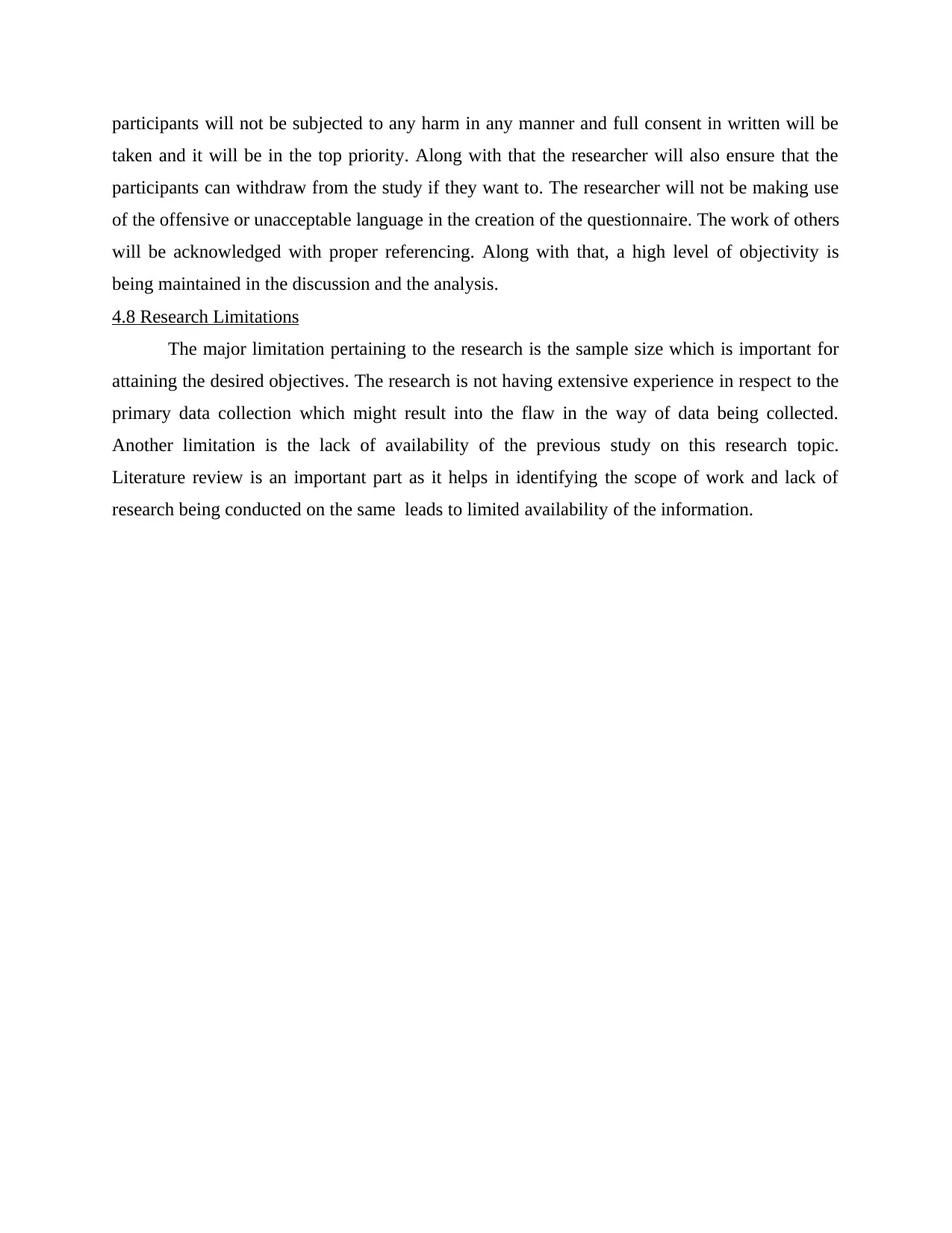
participants will not be subjected to any harm in any manner and full consent in written will be
taken and it will be in the top priority. Along with that the researcher will also ensure that the
participants can withdraw from the study if they want to. The researcher will not be making use
of the offensive or unacceptable language in the creation of the questionnaire. The work of others
will be acknowledged with proper referencing. Along with that, a high level of objectivity is
being maintained in the discussion and the analysis.
4.8 Research Limitations
The major limitation pertaining to the research is the sample size which is important for
attaining the desired objectives. The research is not having extensive experience in respect to the
primary data collection which might result into the flaw in the way of data being collected.
Another limitation is the lack of availability of the previous study on this research topic.
Literature review is an important part as it helps in identifying the scope of work and lack of
research being conducted on the same leads to limited availability of the information.
taken and it will be in the top priority. Along with that the researcher will also ensure that the
participants can withdraw from the study if they want to. The researcher will not be making use
of the offensive or unacceptable language in the creation of the questionnaire. The work of others
will be acknowledged with proper referencing. Along with that, a high level of objectivity is
being maintained in the discussion and the analysis.
4.8 Research Limitations
The major limitation pertaining to the research is the sample size which is important for
attaining the desired objectives. The research is not having extensive experience in respect to the
primary data collection which might result into the flaw in the way of data being collected.
Another limitation is the lack of availability of the previous study on this research topic.
Literature review is an important part as it helps in identifying the scope of work and lack of
research being conducted on the same leads to limited availability of the information.
Paraphrase This Document
Need a fresh take? Get an instant paraphrase of this document with our AI Paraphraser
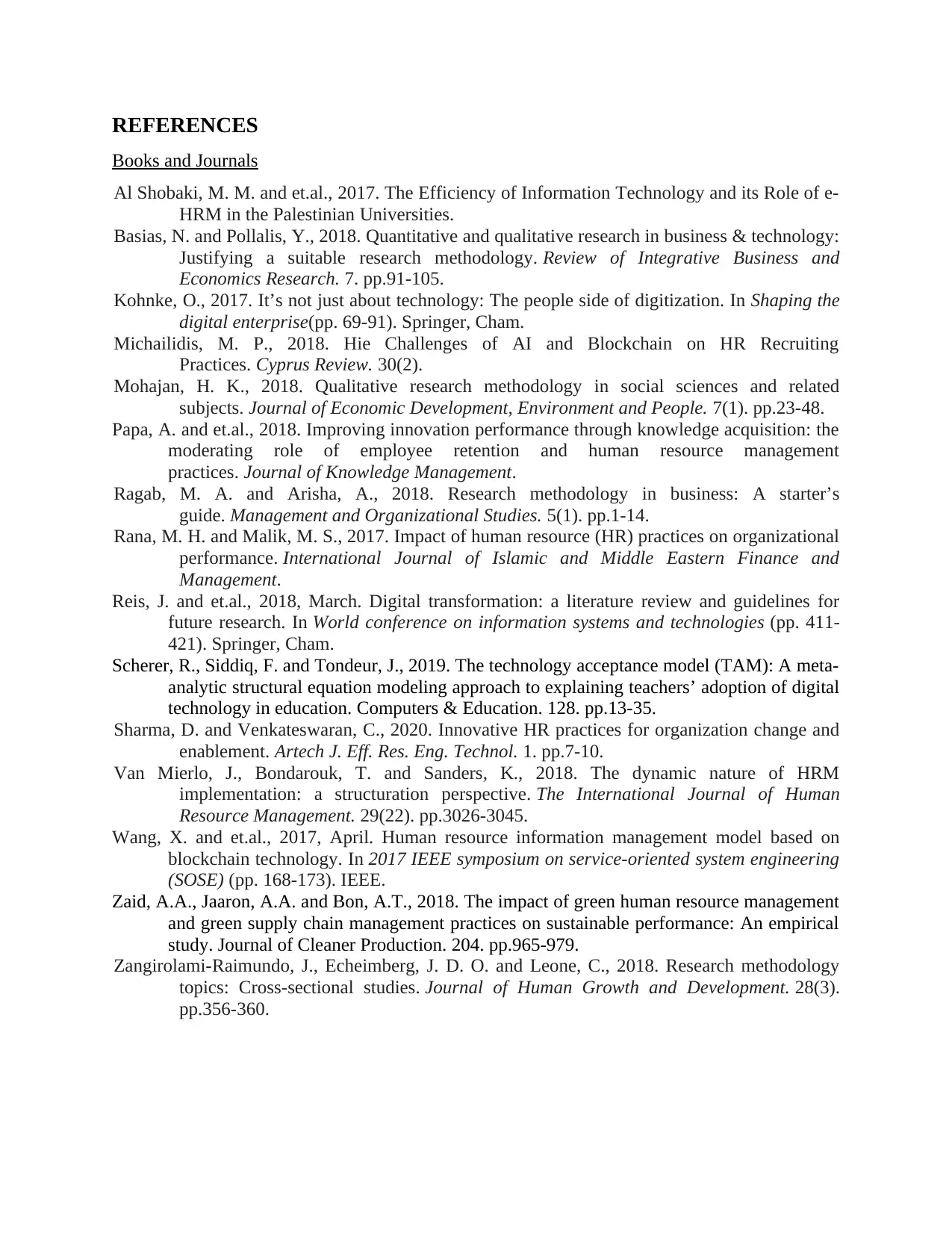
REFERENCES
Books and Journals
Al Shobaki, M. M. and et.al., 2017. The Efficiency of Information Technology and its Role of e-
HRM in the Palestinian Universities.
Basias, N. and Pollalis, Y., 2018. Quantitative and qualitative research in business & technology:
Justifying a suitable research methodology. Review of Integrative Business and
Economics Research. 7. pp.91-105.
Kohnke, O., 2017. It’s not just about technology: The people side of digitization. In Shaping the
digital enterprise(pp. 69-91). Springer, Cham.
Michailidis, M. P., 2018. Hie Challenges of AI and Blockchain on HR Recruiting
Practices. Cyprus Review. 30(2).
Mohajan, H. K., 2018. Qualitative research methodology in social sciences and related
subjects. Journal of Economic Development, Environment and People. 7(1). pp.23-48.
Papa, A. and et.al., 2018. Improving innovation performance through knowledge acquisition: the
moderating role of employee retention and human resource management
practices. Journal of Knowledge Management.
Ragab, M. A. and Arisha, A., 2018. Research methodology in business: A starter’s
guide. Management and Organizational Studies. 5(1). pp.1-14.
Rana, M. H. and Malik, M. S., 2017. Impact of human resource (HR) practices on organizational
performance. International Journal of Islamic and Middle Eastern Finance and
Management.
Reis, J. and et.al., 2018, March. Digital transformation: a literature review and guidelines for
future research. In World conference on information systems and technologies (pp. 411-
421). Springer, Cham.
Scherer, R., Siddiq, F. and Tondeur, J., 2019. The technology acceptance model (TAM): A meta-
analytic structural equation modeling approach to explaining teachers’ adoption of digital
technology in education. Computers & Education. 128. pp.13-35.
Sharma, D. and Venkateswaran, C., 2020. Innovative HR practices for organization change and
enablement. Artech J. Eff. Res. Eng. Technol. 1. pp.7-10.
Van Mierlo, J., Bondarouk, T. and Sanders, K., 2018. The dynamic nature of HRM
implementation: a structuration perspective. The International Journal of Human
Resource Management. 29(22). pp.3026-3045.
Wang, X. and et.al., 2017, April. Human resource information management model based on
blockchain technology. In 2017 IEEE symposium on service-oriented system engineering
(SOSE) (pp. 168-173). IEEE.
Zaid, A.A., Jaaron, A.A. and Bon, A.T., 2018. The impact of green human resource management
and green supply chain management practices on sustainable performance: An empirical
study. Journal of Cleaner Production. 204. pp.965-979.
Zangirolami-Raimundo, J., Echeimberg, J. D. O. and Leone, C., 2018. Research methodology
topics: Cross-sectional studies. Journal of Human Growth and Development. 28(3).
pp.356-360.
Books and Journals
Al Shobaki, M. M. and et.al., 2017. The Efficiency of Information Technology and its Role of e-
HRM in the Palestinian Universities.
Basias, N. and Pollalis, Y., 2018. Quantitative and qualitative research in business & technology:
Justifying a suitable research methodology. Review of Integrative Business and
Economics Research. 7. pp.91-105.
Kohnke, O., 2017. It’s not just about technology: The people side of digitization. In Shaping the
digital enterprise(pp. 69-91). Springer, Cham.
Michailidis, M. P., 2018. Hie Challenges of AI and Blockchain on HR Recruiting
Practices. Cyprus Review. 30(2).
Mohajan, H. K., 2018. Qualitative research methodology in social sciences and related
subjects. Journal of Economic Development, Environment and People. 7(1). pp.23-48.
Papa, A. and et.al., 2018. Improving innovation performance through knowledge acquisition: the
moderating role of employee retention and human resource management
practices. Journal of Knowledge Management.
Ragab, M. A. and Arisha, A., 2018. Research methodology in business: A starter’s
guide. Management and Organizational Studies. 5(1). pp.1-14.
Rana, M. H. and Malik, M. S., 2017. Impact of human resource (HR) practices on organizational
performance. International Journal of Islamic and Middle Eastern Finance and
Management.
Reis, J. and et.al., 2018, March. Digital transformation: a literature review and guidelines for
future research. In World conference on information systems and technologies (pp. 411-
421). Springer, Cham.
Scherer, R., Siddiq, F. and Tondeur, J., 2019. The technology acceptance model (TAM): A meta-
analytic structural equation modeling approach to explaining teachers’ adoption of digital
technology in education. Computers & Education. 128. pp.13-35.
Sharma, D. and Venkateswaran, C., 2020. Innovative HR practices for organization change and
enablement. Artech J. Eff. Res. Eng. Technol. 1. pp.7-10.
Van Mierlo, J., Bondarouk, T. and Sanders, K., 2018. The dynamic nature of HRM
implementation: a structuration perspective. The International Journal of Human
Resource Management. 29(22). pp.3026-3045.
Wang, X. and et.al., 2017, April. Human resource information management model based on
blockchain technology. In 2017 IEEE symposium on service-oriented system engineering
(SOSE) (pp. 168-173). IEEE.
Zaid, A.A., Jaaron, A.A. and Bon, A.T., 2018. The impact of green human resource management
and green supply chain management practices on sustainable performance: An empirical
study. Journal of Cleaner Production. 204. pp.965-979.
Zangirolami-Raimundo, J., Echeimberg, J. D. O. and Leone, C., 2018. Research methodology
topics: Cross-sectional studies. Journal of Human Growth and Development. 28(3).
pp.356-360.

⊘ This is a preview!⊘
Do you want full access?
Subscribe today to unlock all pages.

Trusted by 1+ million students worldwide
1 out of 12
Related Documents
Your All-in-One AI-Powered Toolkit for Academic Success.
+13062052269
info@desklib.com
Available 24*7 on WhatsApp / Email
![[object Object]](/_next/static/media/star-bottom.7253800d.svg)
Unlock your academic potential
Copyright © 2020–2025 A2Z Services. All Rights Reserved. Developed and managed by ZUCOL.





